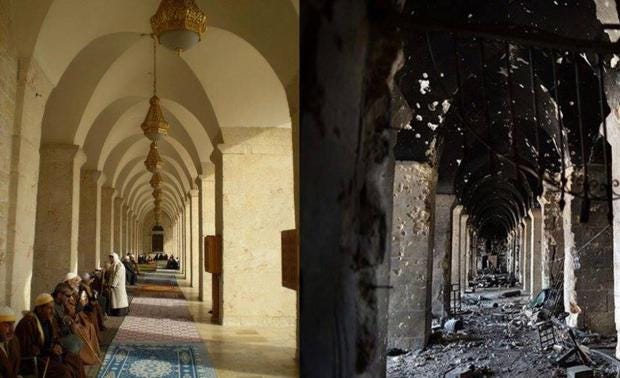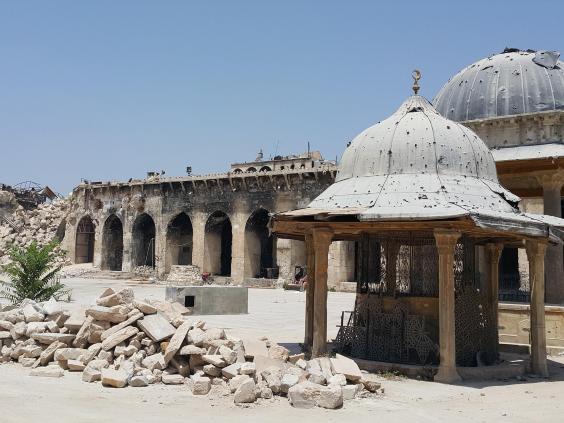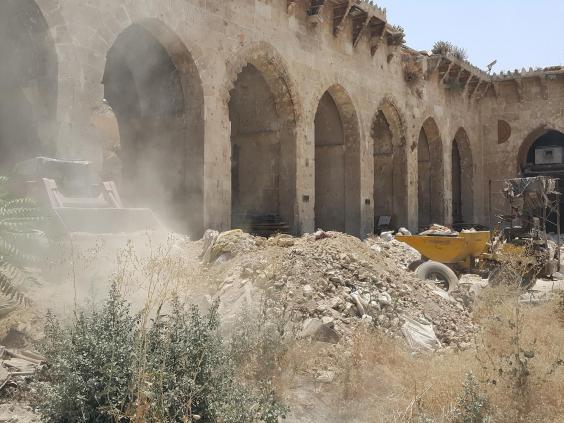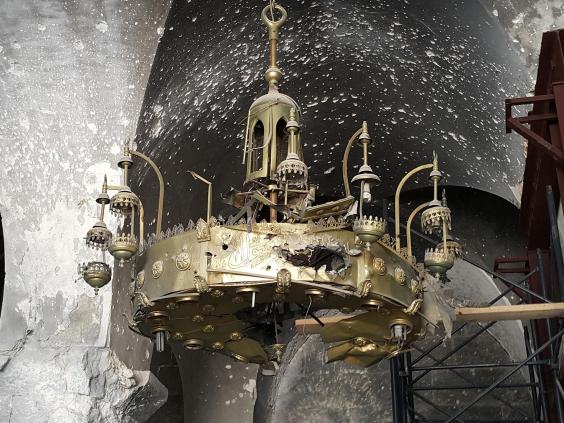In the second instalment of his series from Syria,
Robert Fisk witnesses the restoration of this giant, frequent victim of
history's wars

The crumpled heap of stones, all that is left of the minaret of the Great Mosque of Aleppo,
asks questions of us all. How do we “restore” or “repair” or
“rebuild” a jewel of Seljuk civilization from which millions of Muslims –
perhaps even Saladin himself – were called to prayer five times each
day for 900 years in one of the oldest cities of the world? I run my
hands over these great blocks of masonry, chipped, gashed, some perhaps
reusable, others hopelessly broken, fitted together with infinite care
in 1090, less than 25 years after the Battle of Hastings. I notice
others doing the same.
Mustafa Omran Kurdi has a face so deeply lined and expressive that it might be a map of ancient Aleppo, marks of mourning for both his lost brother and for the minaret of the mosque also known as the Ummayad. The Syrian war has destroyed other shrines, religious and profane. Isis blew up bits of Palmyra, the Syrian army and its enemies fought each other in the glorious souks of Homs and Aleppo. The Syrians say the rebels destroyed the Aleppo minaret, just as the Iraqis blame Isis for detonating the “leaning” minaret of Mosul. The Islamist cultists of Aleppo and Mosul, of course, both blame their opponents; rare indeed is it that the Iraqi regime and the Americans and the Syrian regime end up on the receiving end of the same accusation.
 Given the surviving eyewitnesses in Aleppo, the Ummayad
seems to have collapsed during a storm of shellfire, although several
soldiers and civilians close to the structure say they felt the
vibration of its fall when the rest of the city lay in momentary
silence. The rebels of the time dug deep beneath the streets of Aleppo
to advance their forces and dynamite their opponents. Did they simply
undermine the Ummayad minaret in the north-west corner of the mosque? It
wouldn’t have taken much of a vacuum amid the underground foundations
to shift this gentle, 114-foot high stone creature off balance. The
stones are covered today in a benevolent white dust, untouched since
they fell more than two years ago. The dust clings to your hands. You
can’t do much with dust.
Given the surviving eyewitnesses in Aleppo, the Ummayad
seems to have collapsed during a storm of shellfire, although several
soldiers and civilians close to the structure say they felt the
vibration of its fall when the rest of the city lay in momentary
silence. The rebels of the time dug deep beneath the streets of Aleppo
to advance their forces and dynamite their opponents. Did they simply
undermine the Ummayad minaret in the north-west corner of the mosque? It
wouldn’t have taken much of a vacuum amid the underground foundations
to shift this gentle, 114-foot high stone creature off balance. The
stones are covered today in a benevolent white dust, untouched since
they fell more than two years ago. The dust clings to your hands. You
can’t do much with dust.
But Mustafa Kurdi is the Great Mosque’s reconstruction supervisor – and if energy alone could restore history, he is the man to do it. His hands move around him like construction equipment, as fast as the Bobcat earth-shifter carries rubble from the colonnades five hundred feet away, sandbags and stones and rotting food bags, the detritus of war. “We are preparing now to bring the equipment to move the stones of the minaret and put them together and start to build as close as possible as the original minaret was,” he says. “Maybe some of the stones cannot be used again because they are broken. We shall have to find new stones from perhaps other old sites. If needs be, we can make new stones look like old ones. This is a vast task but we consider our main work is the rebuilding of the minaret.”
 The black and white geometrical stone concourse of the
mosque has largely survived, and although Kurdi and his men were forced
to wall up part of a colonnade temporarily and support two collapsing
pillars with iron bars, much of the structure is – dare one use the
word? – “restorable”. There are wicked bullet gashes in the magnificent
bronze chandeliers with their Koranic script in the colonnade, and stone
walls pitted with holes crueller than any smallpox epidemic would leave
on the human face. Once, this had been a pagan temple and then a Roman
basilica, a Byzantine church – the pattern is familiar in Syria’s
heritage – and then, under the Ummayads in 715 AD, a mosque.
The black and white geometrical stone concourse of the
mosque has largely survived, and although Kurdi and his men were forced
to wall up part of a colonnade temporarily and support two collapsing
pillars with iron bars, much of the structure is – dare one use the
word? – “restorable”. There are wicked bullet gashes in the magnificent
bronze chandeliers with their Koranic script in the colonnade, and stone
walls pitted with holes crueller than any smallpox epidemic would leave
on the human face. Once, this had been a pagan temple and then a Roman
basilica, a Byzantine church – the pattern is familiar in Syria’s
heritage – and then, under the Ummayads in 715 AD, a mosque.
Is there, perhaps, some comfort in the knowledge that the destruction of the Aleppo Great Mosque and its minaret is a recurring feature of ancient history? It was constantly attacked, restored after fire in 1159 by Nureddin and then totally destroyed by the Mongols in 1260. But we are supposed to be better than the Mongol hordes. Besides, there are fewer caliphs to provide the money for such work in the 21st century. And thus we come to the mysterious generosity of Chechnya.
All who work on the mosque say they have heard of this. None
admits any contact with Chechens. It’s all up to the Syrian Ministry of
Religious Affairs, they say. But Russia’s recalcitrant province has
much to do with the Aleppo mosque these days. Chechnya’s chief mufti,
Salakh Mezhiyev, arrived here to lead prayers for a delegation of
Chechen officials. The Kadyrov Foundation, run by the family of Ramzan
Kadyrov, the rebel-turned-loyalist Chechen leader, is apparently funding
the reconstruction of the Aleppo mosque for £5.5m within one year – a
snip if you believe the figures which, according to more
architecturally-minded foreign experts, is far less than half the money
needed for restoration. But, needless to say, it makes Russia look good.
If Moscow can destroy Syria, as the Americans claim, it can also help
to rebuild it. Russian reports that the Kadyrov Foundation publishes no
financial data save for a 2015 asset statement of £19m – and that
Chechens are forced to subscribe to the Kadyrov projects from their
earnings – have not made their way into the Syrian press or television.
It is happier to return to Mustafa Kurdi and his love of the Great Mosque. “When we first entered the mosque [after the fall of eastern Aleppo last winter], the library of the mosque was full of stones and debris and pieces of iron and broken wood,” he says. “We have now cleared 95 per cent of this. Aleppo University made a three-dimensional topographical survey of the sites and the eastern colonnade is now under repair. This will open the way to the eastern souk. You must understand that the difficulty of all this is heritage, historical ‘value’. This is a living structure – a place to pray – and you cannot leave it in this condition. If my house looked like this mosque, I would not live in it.”
 But Kurdi’s argument is more subtle than it might seem. “We
have the materials and the experience in dealing with damage of this
sort but we must remember that when the mosque is restored, everything
else will return – not only those who pray but people shopping who stop
in the colonnades to rest – because the mosque is the heart of this
area. This is not just a religious symbol. It is a social place, part of
our culture.”
But Kurdi’s argument is more subtle than it might seem. “We
have the materials and the experience in dealing with damage of this
sort but we must remember that when the mosque is restored, everything
else will return – not only those who pray but people shopping who stop
in the colonnades to rest – because the mosque is the heart of this
area. This is not just a religious symbol. It is a social place, part of
our culture.”
He was at home in western Aleppo, he says, when he heard of the minaret’s collapse. “My wife’s tears ran down her face,” he says. “Later, these past few months, I saw young people of 16 or 17 come here to learn what happened. Some of the older people were crying. The younger ones were silent. I used to bring my daughter here when she was much younger – she was only eight or nine years old when this happened, but now she says, ‘I remember this place.’”
There
is no doubt where Kurdi places the blame. “It is all these fighters who
attacked this place. How can you make people leave their houses and
their homes? I myself left my home in the Saef al-Dowla area and didn’t
know where to go. Why did the militias attack our houses and our homes?
Islam says you are forbidden from entering a home without permission.
And this mosque is more important than that. After four days, I left my
home in Saef al-Dowla with only the clothes I was wearing.”
By chance, I was in Saef al-Dowla on the very day that Kurdi fled his home. I don’t remember him, but I saw other men and women leaving their homes and asking the soldiers there if they would be protected if they stayed. Gunmen were attacking the soldiers too. It was a middle class area, now back under government control, although Kurdi’s imprecations about “entering a home without permission” did raise other questions in one’s mind. Should these same Islamic instructions not also apply, for example, to the state security police? This was not a question which Mustafa Kurdi asked. He took his family to his aunt’s home in western Aleppo, originally living in just one room. “We all lived there. Then my brother one day went to see our mother and on the way to her a bullet hit him and he was killed and he left four children.”
And each child’s soul, surely, was worth more than a mosque. No, this was not a question to ask Mustafa Kurdi. “We need a soul,” he said. “When Aleppo is rebuilt, it will be because of the love of its people. I have seen people in the destroyed streets putting chairs in front of their shops today, even though the shops have been destroyed. They gradually clean everything away. Aleppo will be rebuilt by its people. We need to see Aleppo again – all of it, because otherwise we will go on missing it. A poet once wrote that the ‘spirit of eagerness to see’ was sufficient for one person in just a glance at a city – but that for those who live there, even if we look constantly at it, it is not enough.”
Mustafa Omran Kurdi has a face so deeply lined and expressive that it might be a map of ancient Aleppo, marks of mourning for both his lost brother and for the minaret of the mosque also known as the Ummayad. The Syrian war has destroyed other shrines, religious and profane. Isis blew up bits of Palmyra, the Syrian army and its enemies fought each other in the glorious souks of Homs and Aleppo. The Syrians say the rebels destroyed the Aleppo minaret, just as the Iraqis blame Isis for detonating the “leaning” minaret of Mosul. The Islamist cultists of Aleppo and Mosul, of course, both blame their opponents; rare indeed is it that the Iraqi regime and the Americans and the Syrian regime end up on the receiving end of the same accusation.

Rubble in the courtyard of the Great Mosque with stone remains of the minaret far left (Photo: Nelofer Pazira)
But Mustafa Kurdi is the Great Mosque’s reconstruction supervisor – and if energy alone could restore history, he is the man to do it. His hands move around him like construction equipment, as fast as the Bobcat earth-shifter carries rubble from the colonnades five hundred feet away, sandbags and stones and rotting food bags, the detritus of war. “We are preparing now to bring the equipment to move the stones of the minaret and put them together and start to build as close as possible as the original minaret was,” he says. “Maybe some of the stones cannot be used again because they are broken. We shall have to find new stones from perhaps other old sites. If needs be, we can make new stones look like old ones. This is a vast task but we consider our main work is the rebuilding of the minaret.”

Digger clearing stones from the courtyard of the Aleppo Umayyad Great Mosque (Photo: Nelofer Pazira)
Is there, perhaps, some comfort in the knowledge that the destruction of the Aleppo Great Mosque and its minaret is a recurring feature of ancient history? It was constantly attacked, restored after fire in 1159 by Nureddin and then totally destroyed by the Mongols in 1260. But we are supposed to be better than the Mongol hordes. Besides, there are fewer caliphs to provide the money for such work in the 21st century. And thus we come to the mysterious generosity of Chechnya.
Aleppo before the Syrian Civil War
It is happier to return to Mustafa Kurdi and his love of the Great Mosque. “When we first entered the mosque [after the fall of eastern Aleppo last winter], the library of the mosque was full of stones and debris and pieces of iron and broken wood,” he says. “We have now cleared 95 per cent of this. Aleppo University made a three-dimensional topographical survey of the sites and the eastern colonnade is now under repair. This will open the way to the eastern souk. You must understand that the difficulty of all this is heritage, historical ‘value’. This is a living structure – a place to pray – and you cannot leave it in this condition. If my house looked like this mosque, I would not live in it.”

Brass chandeliers in the Aleppo Great Mosque were shattered by bullets. (Photo: Nelofer Pazira)
He was at home in western Aleppo, he says, when he heard of the minaret’s collapse. “My wife’s tears ran down her face,” he says. “Later, these past few months, I saw young people of 16 or 17 come here to learn what happened. Some of the older people were crying. The younger ones were silent. I used to bring my daughter here when she was much younger – she was only eight or nine years old when this happened, but now she says, ‘I remember this place.’”
By chance, I was in Saef al-Dowla on the very day that Kurdi fled his home. I don’t remember him, but I saw other men and women leaving their homes and asking the soldiers there if they would be protected if they stayed. Gunmen were attacking the soldiers too. It was a middle class area, now back under government control, although Kurdi’s imprecations about “entering a home without permission” did raise other questions in one’s mind. Should these same Islamic instructions not also apply, for example, to the state security police? This was not a question which Mustafa Kurdi asked. He took his family to his aunt’s home in western Aleppo, originally living in just one room. “We all lived there. Then my brother one day went to see our mother and on the way to her a bullet hit him and he was killed and he left four children.”
And each child’s soul, surely, was worth more than a mosque. No, this was not a question to ask Mustafa Kurdi. “We need a soul,” he said. “When Aleppo is rebuilt, it will be because of the love of its people. I have seen people in the destroyed streets putting chairs in front of their shops today, even though the shops have been destroyed. They gradually clean everything away. Aleppo will be rebuilt by its people. We need to see Aleppo again – all of it, because otherwise we will go on missing it. A poet once wrote that the ‘spirit of eagerness to see’ was sufficient for one person in just a glance at a city – but that for those who live there, even if we look constantly at it, it is not enough.”